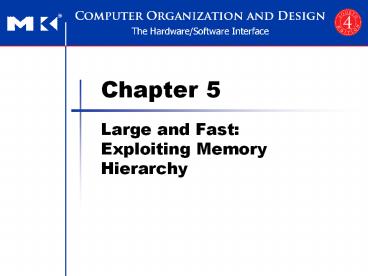Large and Fast: Exploiting Memory Hierarchy - PowerPoint PPT Presentation
Title:
Large and Fast: Exploiting Memory Hierarchy
Description:
Chapter 5 Large and Fast: Exploiting Memory Hierarchy Morgan Kaufmann Publishers * Chapter 5 Large and Fast: Exploiting Memory Hierarchy * Chapter 5 Large and ... – PowerPoint PPT presentation
Number of Views:439
Avg rating:3.0/5.0
Title: Large and Fast: Exploiting Memory Hierarchy
1
Chapter 5
- Large and Fast Exploiting Memory Hierarchy
2
Memory Technology
5.1 Introduction
- Static RAM (SRAM)
- 0.5ns 2.5ns, 2000 5000 per GB
- Dynamic RAM (DRAM)
- 50ns 70ns, 20 75 per GB
- Magnetic disk
- 5ms 20ms, 0.20 2 per GB
- Ideal memory
- Access time of SRAM
- Capacity and cost/GB of disk
3
Principle of Locality
- Programs access a small proportion of their
address space at any time - Temporal locality
- Items accessed recently are likely to be accessed
again soon - e.g., instructions in a loop, induction variables
- Spatial locality
- Items near those accessed recently are likely to
be accessed soon - E.g., sequential instruction access, array data
4
Taking Advantage of Locality
- Memory hierarchy
- Store everything on disk
- Copy recently accessed (and nearby) items from
disk to smaller DRAM memory - Main memory
- Copy more recently accessed (and nearby) items
from DRAM to smaller SRAM memory - Cache memory attached to CPU
5
Memory Hierarchy Levels
- Block (aka line) unit of copying
- May be multiple words
- If accessed data is present in upper level
- Hit access satisfied by upper level
- Hit ratio hits/accesses
- If accessed data is absent
- Miss block copied from lower level
- Time taken miss penalty
- Miss ratio misses/accesses 1 hit ratio
- Then accessed data supplied from upper level
6
Cache Memory
- Cache memory
- The level of the memory hierarchy closest to the
CPU - Given accesses X1, , Xn1, Xn
5.2 The Basics of Caches
- How do we know if the data is present?
- Where do we look?
7
Direct Mapped Cache
- Location determined by address
- Direct mapped only one choice
- (Block address) modulo (Blocks in cache)
- Blocks is a power of 2
- Use low-order address bits
8
Tags and Valid Bits
- How do we know which particular block is stored
in a cache location? - Store block address as well as the data
- Actually, only need the high-order bits
- Called the tag
- What if there is no data in a location?
- Valid bit 1 present, 0 not present
- Initially 0
9
Cache Example
- 8-blocks, 1 word/block, direct mapped
- Initial state
Index V Tag Data
000 N
001 N
010 N
011 N
100 N
101 N
110 N
111 N
10
Cache Example
Word addr Binary addr Hit/miss Cache block
22 10 110 Miss 110
Index V Tag Data
000 N
001 N
010 N
011 N
100 N
101 N
110 Y 10 Mem10110
111 N
11
Cache Example
Word addr Binary addr Hit/miss Cache block
26 11 010 Miss 010
Index V Tag Data
000 N
001 N
010 Y 11 Mem11010
011 N
100 N
101 N
110 Y 10 Mem10110
111 N
12
Cache Example
Word addr Binary addr Hit/miss Cache block
22 10 110 Hit 110
26 11 010 Hit 010
Index V Tag Data
000 N
001 N
010 Y 11 Mem11010
011 N
100 N
101 N
110 Y 10 Mem10110
111 N
13
Cache Example
Word addr Binary addr Hit/miss Cache block
16 10 000 Miss 000
3 00 011 Miss 011
16 10 000 Hit 000
Index V Tag Data
000 Y 10 Mem10000
001 N
010 Y 11 Mem11010
011 Y 00 Mem00011
100 N
101 N
110 Y 10 Mem10110
111 N
14
Cache Example
Word addr Binary addr Hit/miss Cache block
18 10 010 Miss 010
Index V Tag Data
000 Y 10 Mem10000
001 N
010 Y 10 Mem10010
011 Y 00 Mem00011
100 N
101 N
110 Y 10 Mem10110
111 N
15
Address Subdivision
16
Example Larger Block Size
- 64 blocks, 16 bytes/block
- To what block number does address 1200 map?
- Block address ?1200/16? 75
- Block number 75 modulo 64 11

